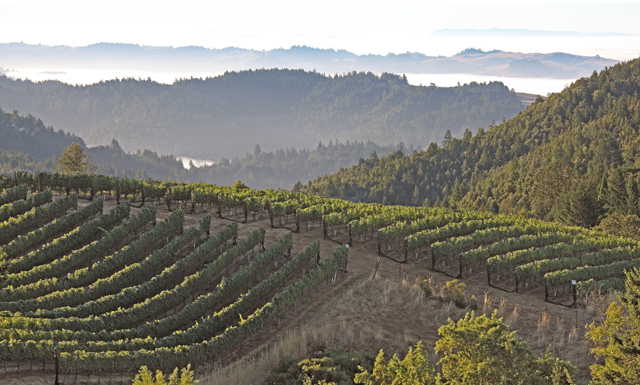The Little AVA That Could
By John Lenart in Food on Jul 25, 2014 7:30PM

(Image courtesy Fort Ross-Seaview Winegrowers Association)
Ask a Frenchman about a particular wine and he’ll tell you about the place it's from. Ask an American and the first thing she'll talk about is the grape varietal. Part of the reason for this is that, in most of the old world, law dictates what grapes for wine production can be grown in a given area. These areas are referred to as appellations. So, when you talk about a red Bordeaux, you already know that this wine can only be made from five approved grape varieties, cabernet sauvignon, merlot, cabernet franc, petit verdot and malbec. In the U.S. when talking about say, a red Napa Valley wine, it could be made from just about any red grape variety.
Why are we, as Americans, so different when it comes to this? OK, the rest of the new world looks at wine like this too. Well, I'm sure part of it is the notion that as Americans, we're free to grow what grapes we want, where we want. It's part of that pioneering tradition that made America what it is today.
So we focus on the grape. That's what's in the bottle right? But, when it comes to American wine, we really should pay closer attention to where it comes from. Here's why: Now, I have more than a little affinity with pinot noir. I love the stuff, and it gives us a great example of why where American wine comes from is as important as what grape is used to make the wine itself. Pinot noir from the Russian River Valley can be big and super fruit forward. Head south to Carneros and it can produce more delicate wines. Napa Valley Pinot noir can be downright huge. Same grape, same vintage, radically different wines. This is why the “where” of wine is important.
In the old world we'd be talking about what is called appellation, which are specific regions that possess common soil and climate characteristics. Appellations often have strictly enforced restrictions regarding what types of grapes can be grown. The U.S., on the other hand, uses the term American Viticultural Area, or AVA. These areas are defined by the Alcohol and Tobacco Tax Bureau (TTB), which is part of the United States Department of Treasury. Each AVA possesses distinguishable geographic features, but, unlike old world appellations, no restrictions are placed onto what types of grapes can be grown there. If a wine lists it's AVA on the label it means that at least 85% of the grapes used to make the wine in that bottle must be grown in that AVA.
Now, I'm sure you know the biggies like Napa Valley, Sonoma County and Mendocino. But there are a lot of smaller AVAs out there. In fact, they can be nested inside of other larger AVAs. Also, unlike the old world, where strict boundaries around appellations were drawn centuries ago and never change, in the U.S. the TTB can be petitioned to create new AVAs.
I was recently introduced to a fairly new AVA that I'm quite excited about. Fort Ross-Seaview. This new AVA is nested within the Sonoma Coast AVA. Fort Ross-Seaview became an AVA in January 2012. The name Fort Ross comes from the outpost set up by Russian fur trappers in 1817. It was at this time that the first grapes were planted in the area from Peruvian cuttings.
Fort Ross-Seaview is located about 65 miles north of San Francisco in the western part of Sonoma County, close to the Pacific Ocean, between elevations of 920 and 1800 feet. Although the AVA is 27,500 acres (43 sq. miles), only a mere 555 acres are vineyards.
Because of its proximity to the ocean the temperatures are much more moderate than even nearby AVA's like neighboring Russian River Valley and Anderson Valley. However, because of its elevation, the AVA typically stays above the fog allowing the grapes long sunny days to grow. This combination makes a great environment for growing cool climate grapes like those of Burgundy: chardonnay and pinot noir.
According to Linda Schwartz proprietor of the Fort Ross Vineyard, Winery & Tasting Room and member of the Fort Ross-Seaview Winegrowers Association, “The feeling among winemakers is that this will become the premier Burgundian grape wine growing area.”
Vineyards and wineries in the AVA include Del Dotto Cinghiale Vineyard, Fort Ross Vineyard, Winery & Tasting Room, Hellenthal Vineyard, Martinelli Winery, Pahlmeyer’s Wayfarer Vineyard, Precious Mountain Vineyard, and Wildhog Vineyard.
I was turned onto wines from Fort Ross-Seaview AVA recently while having dinner at Elizabeth (4835 N. Western Ave.). The wine was Fort Ross “Sea Slopes” Pinot Noir, 2011. Technically this wine is not Fort Ross-Seaview because in 2011 the AVA did not yet exist. Remember, wines from this AVA prior to the 2012 vintage will be classified as Sonoma Coast. But the wine was outstanding. Very Burgundian in style, funky barnyard notes (trust me this is a good thing!), good fruit but not flabby like warmer climate pinot noirs, and it had good acidity. All of this is brought to the bottle because of the unique growing conditions and the skilled winemakers and growers in the AVA.
I am excited to try more Fort Ross-Seaview AVA wines as they are released. You should check them out too.